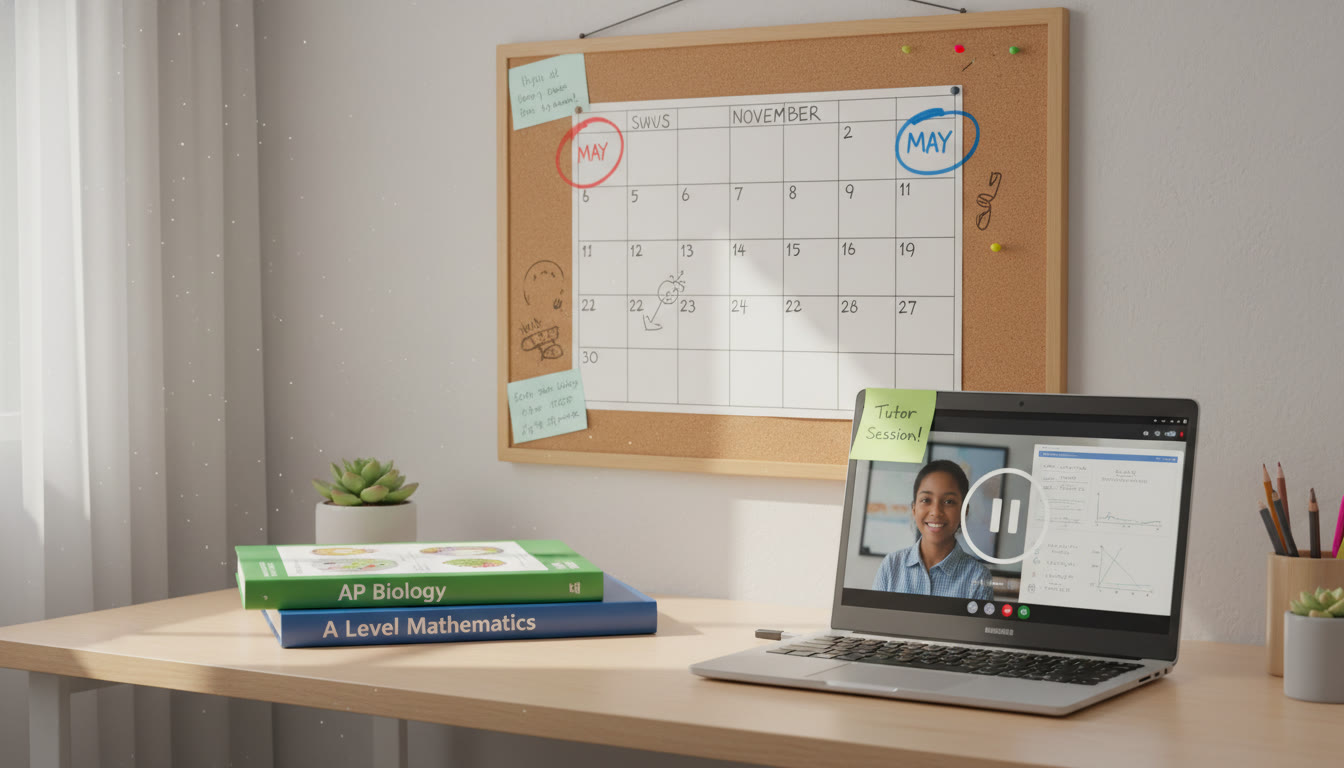Why a combined annual calendar matters for families doing A Levels and APs
Planning for high-stakes exams can feel overwhelming: different systems, different deadlines, different rhythms. If your household includes students taking A Levels (AS/A2) and Advanced Placement (AP) courses — or if you’re a school counselor juggling both programs — a single, sensible annual calendar is a game changer. It turns reactive panic into proactive progress, clarifies when to register and when to submit coursework, and helps parents and students align study habits, college planning, and well‑being across the entire year.

Big-picture differences — A Levels vs AP at a glance
Before we map dates and actions, here are the core distinctions that shape how you plan:
- Structure: A Levels are typically split into AS (first half) and A2 (final half) units, often spread across two years; AP courses are single‑year classes culminating in a single AP Exam in May.
- Exam Windows: AP exams follow a fixed two-week window in May (with late testing options); A Level exams happen mainly in May/June and sometimes January (for certain centers or retakes), with exam boards publishing detailed timetables annually.
- Assessment Types: Both use written exams, but A Levels may include long, cumulative papers and internal assessments depending on the subject; APs often combine multiple‑choice and free‑response sections and, for some subjects, submitted digital portfolios or performance tasks.
- Registration and Deadlines: AP registration is coordinated by schools with firm ordering deadlines in the autumn; A Level registration works through school exam officers with their own timelines, often earlier for private candidates.
Annual timeline — month‑by‑month roadmap (school year view)
This calendar is designed for a typical northern hemisphere school year that runs roughly from late summer/early autumn to late spring/early summer. It highlights recurring tasks and planning checkpoints students and parents should know.
July – September: Reflect, recharge, and set big goals
- Review last year’s results and identify subjects or skills to improve.
- Decide whether to take AP exams in May and whether to sit AS or A2 modules next year.
- Start building a preliminary study calendar; block major family events and vacations to avoid clashes with key study periods.
- If you plan to take APs, talk to teachers about anticipated course offerings and any summer assignments.
October – November: Registration and administrative deadlines
This is a critical admin window. For AP exams, schools typically submit orders in the fall; many exam boards for A Levels also require early confirmation of entries.
- Confirm AP exam intent with your AP coordinator — many schools set a November ordering deadline.
- Register or confirm A Level entries with the school exam officer. Private candidates should confirm deadlines with their exam center.
- Ask about financial assistance, fee waivers, or installment plans if costs are a concern.
December – February: Build momentum, consolidate content
- Start targeted review cycles — don’t cram. Use spaced repetition for facts and periodic timed practice for exam technique.
- For A Levels, students taking modules in January should finalize topic reviews and past‑paper practice.
- AP students should complete any performance tasks early (if the exam requires portfolios or digital submissions, verify dates — some tasks are due in spring).
- Keep communication open with teachers; early detection of gaps is far easier to remedy than last‑minute panic.
March – April: Intensify practice, solidify logistics
This is the final buildup. Peak study doesn’t mean endless hours; it means smart, simulated practice.
- Begin full‑scale, timed practice exams under real conditions. Review marking rubrics and examiner reports to understand what earns top marks.
- Confirm exam room assignments and reminder details with the AP coordinator and A Level exam officer.
- Submit any AP Digital Portfolio tasks and A Level coursework components with time to spare for corrections.
- Adjust sleep schedules gradually so peak alertness aligns with real exam start times.
May – June: Exam window(s) and recovery
AP exams take place in a standardized two‑week window in May. A Levels usually run in May/June. Students might have overlapping intense periods — plan rest days, nutrition, and short active recovery between papers.
- Follow the exact start-time policies — morning exams typically begin around 8 a.m., afternoon sessions at noon for APs (local times subject to official schedule).
- Use micro‑routines between exams: light exercise, a 20‑minute nap when needed, and brief, focused review only if it calms rather than stresses.
- Celebrate completion and begin low‑stakes decompression immediately after exams end.
June – July: Results, appeals, and next steps
Results for AP and A Levels are released at different times; familiarize yourself with the release calendar and procedures for re‑marking or appeals if needed.
- When results arrive, review them calmly. If a grade is surprising, speak with your teacher or tutor before deciding on a remark or review.
- For college planning, use AP scores to consider credit or placement options; A Level grades directly impact university offers, so understand conditional offer requirements.
- Begin planning for the next academic year — course selections, retakes, gap mitigation strategies.
Practical comparison table: timing, checkpoints, and common actions
The table below condenses the most important recurring dates and actions families should track.
| Item | AP (Typical U.S./International Cycle) | A Levels (AS/A2 Typical Cycle) | Action for Families |
|---|---|---|---|
| Main exam window | Early May (two weeks; morning and afternoon sessions) | May–June (some boards offer January papers; schedule varies) | Mark calendars; avoid scheduling major events during these windows |
| Registration deadlines | School ordering deadlines in the fall (schools submit orders) | Registration and entry deadlines set by school/exam center (often autumn) | Confirm entries by October/November; pay fees and complete paperwork early |
| Performance task/Portfolio due dates | Varies by subject; many digital submissions due in late April/early May | Coursework deadlines vary; often submitted earlier in the spring | Plan drafts weeks in advance; leave time for teacher feedback |
| Late testing / resits | Late testing available with alternate forms (for eligible students) | Many boards allow summer series and retakes; check center policies | Ask coordinators about late-testing policies and deadlines |
Sample study plan: 16‑week sprint to AP/A2 exams
Below is a flexible 16‑week plan suitable for a student balancing either AP exams or the second year (A2) of an A Level subject. Adjust the block lengths to match your syllabus and personal pacing.
- Weeks 1–4 — Foundation & Diagnostics: Take a diagnostic practice paper, map weak areas, set weekly micro‑goals, and refresh fundamentals.
- Weeks 5–8 — Skill Building: Focus on the three hardest topic clusters. Use active recall, teach‑back sessions, and problem sets with marked timing.
- Weeks 9–12 — Application & Timing: Start timed sections, simulate exam conditions once per week, and incorporate examiner mark schemes into feedback.
- Weeks 13–14 — Polishing: Iron out careless errors, revise formula sheets and subject glossaries, and practice high‑yield essay structures or calculation techniques.
- Week 15 — Full Simulations: Complete two full-length, timed exams spaced with three days in between for review.
- Week 16 — Rest & Light Review: Taper intensity. Short, targeted reviews on the morning of exam days; focus on sleep and nutrition.
How to schedule study with other commitments
Students often juggle extracurriculars, part‑time jobs, and family time. The secret is quality over quantity: shorter, focused sessions beat passive long hours. Try the following weekly template:
- Weekdays: 4–6 focused sessions of 40–60 minutes (active recall, problem sets, or essays).
- Two evenings per week: light review or group study to consolidate.
- Weekend: one long block (2–3 hours) for full practice tests or deep projects, plus one recovery block for social/leisure time.
Common pitfalls and how to avoid them
Avoiding a few predictable mistakes saves hours — and stress.
- Waiting to register: Administrative errors and missed deadlines can cost money or lock you out of an exam. Confirm early in the autumn.
- Overloading with subjects: More is not always better. Balance ambition with realistic time allocation; three to four well‑prepared APs or A Levels are often stronger than six rushed ones.
- Ignoring examiner expectations: Past papers and mark schemes reveal what examiners reward. Model answers are a goldmine.
- All or nothing studying: Daily micro‑reviews maintain memory far better than single huge cram sessions.
How parents can help without taking over
Supportive, informed parents are invaluable. Here’s how to help constructively:
- Be the logistics manager: help with calendars, deadlines, and paperwork, but let the student own the study plan.
- Encourage consistent sleep, hydration, and movement — cognitive performance is biological as much as intellectual.
- Offer emotional support: normalize nervousness and celebrate small wins.
- When needed, connect students with tailored help; personalized tutoring can be an efficient use of time and resources.
Personalized tutoring — the smart supplement
Not every student needs a tutor full‑time, but many benefit from focused, expert guidance on weak areas, exam technique, or motivation. Personalized tutoring — like Sparkl’s 1‑on‑1 guidance — can provide:
- Tailored study plans that align with your exam calendar and learning style.
- Expert tutors who translate examiner expectations into practical strategies.
- AI‑driven insights to highlight knowledge gaps and prioritize high‑impact practice.
- Flexible scheduling around school and family commitments, minimizing burnout.
Used thoughtfully, tutoring speeds progress and builds confidence — not dependence.
Real‑world examples: two student profiles and how they use the calendar
Emma — AP-heavy senior planning for May exams
Emma is taking four APs (Calculus BC, Biology, English Lit, and U.S. History). She set a fall registration checkpoint, used November to finalize orders, and created a weekly rotation where days focus on one subject with mixed retrieval practice. From March, Emma switched to full‑length timed practice on weekends and booked three targeted Sparkl sessions to refine her essay technique and exam timing. The result: calmer exam days and confident pacing during multi‑hour testing.
Ravi — A2 student balancing university conditional offers
Ravi is in his final A Level year. He mapped each paper’s date from the exam board timetable months in advance, assigned 2–3 high‑yield topics per week, and completed past papers under time limits. For laboratory reports and coursework, he scheduled teacher feedback deadlines two weeks before final submission. When some midterms revealed gaps in mechanics and calculus, he used a short tutoring block to hone problem‑solving patterns and avoided last‑minute cramming.
Checklist: What to do each quarter
- Quarter 1 (Aug–Oct): Confirm course choices; note registration deadlines; book tutoring if needed.
- Quarter 2 (Nov–Jan): Finalize exam entries; check requirements for portfolios or coursework; begin steady practice.
- Quarter 3 (Feb–Apr): Full practice exams; finalize submissions; taper extracurriculars as needed.
- Quarter 4 (May–Jun): Exams, recovery, and results processing; plan next steps (retakes, college placement).
Putting it together: a one‑page printable family action plan
Every family should have a one‑page action plan pinned in a visible place. Include:
- Key dates for AP exam window and A Level sessions (month and week).
- Registration deadlines and contact info for the AP coordinator/exam officer.
- Scheduled full‑length practice exam dates and tutoring check‑ins.
- A short crisis plan for unexpected events (illness, technical issues, family emergencies) — who to call, documentation to collect, how late‑testing works.
Final thoughts: rhythm, resilience, and realistic ambition
Exams are important, but they’re not the whole story. A clear calendar helps create rhythm — pockets of intense focus, predictable breaks, and time for reflection. When planning, prioritize resilience: real learning comes from steady practice, honest feedback, and strategic recovery. Personalized tutoring, like Sparkl’s tailored plans and expert tutors, can smooth the path when students face stubborn gaps or need help converting knowledge into exam performance.
Above all, remember that a well‑constructed calendar is a promise, not a prison. Use it as a guide to protect study time and preserve mental health. With the right plan, support, and sensible pacing, students can enter A Levels and AP exams confident, prepared, and ready to show what they know.

Quick reference — action items for today
- Check your school’s AP ordering deadline (usually in the fall) and mark it on your calendar.
- Ask your exam officer for the A Level entry deadline for your center and note any coursework submission dates.
- Schedule one diagnostic timed practice test for each subject you’re taking within the next two weeks.
- If you want targeted help, book an introductory session with a tutor to create a 16‑week plan tailored to your exams.
Good luck — and remember: steady, focused preparation beats last‑minute frenzy every time. With a clear calendar and the right support, students can face exam season with calm and confidence.
















No Comments
Leave a comment Cancel